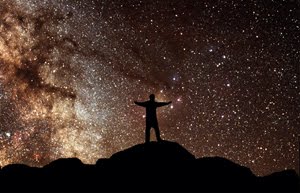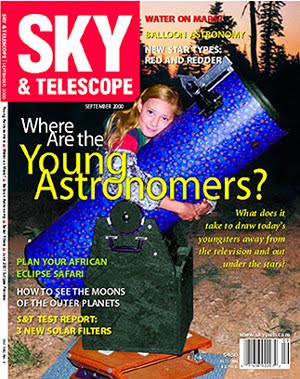I had not planned on going observing Saturday. The way I figured it, I would not observe outside of my own backyard for almost two weeks. With the moon up until after midnight there was not much incentive, except I really wanted to play with the 8" compact scope. So, late afternoon I began to pack up my 1980 Mercedes, to test out putting an 8" f/7 in the trunk and see how much room would be left.
The packing job was a great success as the scope fit into the trunk easily, front to back. Two large plastic boxes, one containing books, atlases, notes, and other observing goodies, the other full of cold weather clothes, accompanied the OTA in the trunk. The base, which I am going to eventually make collapsible in order to put it in the trunk also, sat in the back seat with my eyepiece case. At that point Mimi saw I was packed up and asked what I was doing. Of course, she immediately asked if she could go. Since she had not been to Fremont Peak in over a year, and I knew some TACos were planning on the SW lot, I suggested we go there (I didn't want dirt in the open frame of the scope). Mimi was extremely pleased.
So, with loads of room to spare, we headed south, to the place we both cut our observing teeth.
It was fun to use the little car instead of the Suburban. Heading south of Gilroy the gentle rolling hills were lush green. As we left Santa Clara County into San Benito we climbed through the low pass that leads to highway 156 and the turnoff to San Juan Bautista. I have to admit, this seemed very familiar, evoking feelings of deja vu, although I knew that I had been there previously. Turning off toward SJB the hills laid out to our north and south as we drove through the pasture lands on each side. It was gorgeous. A quick stop at the old familiar Windmill Market to pick up dinner, and we were on our way up San Juan Canyon Road, which terminates at Fremont Peak State Park.
The road was really just too much fun to drive. Granite boulders strewn along the east side, the stream flowing along the western side. Cows, horses, sheep, chicken. Wild turkey, hawks, rabbit, the wildlife was evident everywhere. We climbed up the canyon through overhanging oaks draped in Spanish Moss. I felt the years peel away, remembering the young lady sitting next to me as a child learning the constellations when the sky was much darker than it is today.
Arriving at the SW lot, we were the first amateur astronomers. The only thing missing was Jim Bartolini, who would invariably be the first one there on observing weekends. It was cool and breezy, mist blowing over the Peak and forming a trailing cloud to the east. Looked almost like a volcano with smoke billowing out. Jamie and Liam Dillon pulled in just minutes later.
I have to admit it felt a lot like home. Like driving through the neighborhood you grew up in, remembering all those childhood experiences. The friends, the funny things that happened. Nostalgia.
I popped open my big can of Fosters and shared it with Jamie. At this point, I didn't care if I did any observing, I was thoroughly enjoying the quiet familiarity of the place. As it turned out, there was little observing anyway.
After setting up the scope, Nilesh Shaw arrived. The three of us, along with Mimi and Liam, would comprise the non-Coe contingent of TAC. High cloud came through in waves. One minute we'd be hunting some faint fuzzy, the next minute we'd lose the stars. We did observe a good number of bright Messiers. Jamie was having fun around M109. I pulled in M53 and Nilesh then went to M64 with my scope. M51 didn't look like much. Nilesh and I then had a friendly contest taking turns trying to find NGC 6210 in Hercules (we did find it).
During all this Mimi and I walked to the pay phone to call home, then on to the observatory. On the way I noted one lone amateur astronomer set up on Coulter Row. As I passed below him on the road I saw a family camping on the hill just above him... their campfire and Coleman lantern silhouetting the observer and his telescope. Another campfire blazed at the bottom of Coulter Row, and yet another up at the top of it. Half a dozen or so cars drove in or out of the park while we walked to the road up to the observatory. I don't know how anyone observes there. I don't know how we did it!
What I do recall about the place were the friends and the dark sky. On a good summer dark sky Saturday you'd need to arrive around mid-day to secure a good place to set up. If you were at the lower end of Coulter, you were there for the night due to the large number of set ups between you and the exit. I am not exaggerating when I say there were times when you could find a hundred telescopes set up on Coulter, the overlook lot (not the southwest lot), and along the road to the right of the pay phone. You needed a red flashlight to be certain you didn't run into equipment when walking to the bathrooms, or looking for friends. The place was awesome, especially for a newcomer. And while the Mark Cherringtons and John Gleasons among us will say the Peak was done by 1990 (in fact, some say it was history by 1980), it was the darkest place I knew of. People look at me in disbelief when I say you could not make out your neighbor's face. True.
But, back to today.
As the observatory came into view we noticed the roof rolled back and a white light on in the meeting room. The 30" Challenger was being "guided" by The Sky software and digital setting circles to The Ghost Of Jupiter (NGC 3242). I had a chuckle looking at the crosshairs on the monitor and saying "Ghost Of Jupiter?" to the person operating the program. He replied "no, we're not looking at Jupiter"... :-)
Ron Dammann was at the eyepiece. When he stepped back to let the public have a look I said hi to him. He said this was the third night of public programs at the Peak. I told him I was with a few friends, and said goodbye. In the meeting room someone was giving a talk on Olympus Mons to a group of maybe a dozen. I remembered Rod Norden in his wizard's costume, pointed hat, robed, giving a similar talk. Afterwards, Alan Nelms, Rich Neuschaefer, Dean Linebarger and I would run the 30" for the public. We had some great times up there.
Mimi loves the place. On the way back she fantasized about becoming wildly wealthy and purchasing the park from the state (kids and their imaginations!) and bequeathing it to amateur astronomers in perpetuity.
We arrived back at the SW lot and did a bit more hunting at the scope. Mimi laid down on the ground next to the car, wrapped up in a warm blanket, head on her pillow, and fell asleep while the clouds pulled a cover across the sky.
After a lot of talking, and calling James Turley by cell phone over at Coe to "rub in" what a great time we were having at the Peak, it was time to pack up. I could hardly believe it took less than 5 minutes to have everything put away and be heading down the hill.
The road down was still virtually auto pilot. Under 20 minutes and I was back on the highway. We were home in bed by 1:40 a.m.
For a poor night of observing, we sure had a great time.











